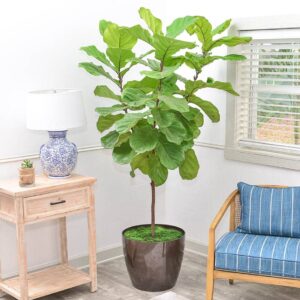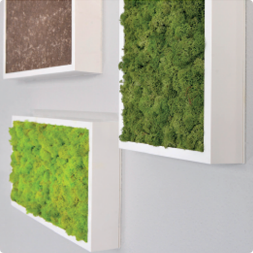Fiddle Leaf Fig Care Guide
Caring for your Ficus Lyrata
The Fiddle Leaf Fig is still the mainstay trendsetter in the plant community, and continues to give the millennial favorite, the Monstera Deliciosa, a run for its money these past couple of years. You have probably seen this large-leaf lovely swarming the internet and taking the world by storm, so we won’t waste too much time with introductions. It truly is one of the most popular indoor plants. You might also hear it referred to as its scientific name the Ficus Lyrata, but it has coined the nickname Fiddle Leaf Fig throughout pop culture, from its newfound popularity in the current generation of plant parents, who are actually choosing to forego having children in favor of an oxygen-producing companion.
This plant is the true “it” plant currently due to its large and violin-shaped leaves that resemble fiddles – hence the name! They have taken the interior design industry by storm and are almost always incorporated in Modern home design and the Bohemian design nowadays that we are seeing as some of the most popular forms of décor along with the industrial design.
The Ficus Lyrata can come in a variety of shapes and sizes but has two main styles that it comes in. The two styles you will see Fiddle Leaf Figs in are the standard tree form and the bush from. The standard tree tends to be the more popular of the two forms when it comes to the millennial buyers, but the bush is more leafy and tends to be fuller having leaves that reach all the way to the bottom of the stem, which can warrant a lot of attention as well since it really draws the eyes to it. Both are fantastic options for either the Modern home design and Bohemian home design but we are seeing more and more people prefer the tree form over the bush form.
Something else great about the Ficus Lyrata – it is really great for both beginning plant owners and experienced plant owners. Anyone willing to put in the work will succeed at taking care of this plant. It photographs well – so snap lots of pictures, and the Ficus Lyrata does a fantastic job of holding up and staying pretty as long as it gets lots of light making it one photogenic plant. So beginners should not be discouraged by the plant care regimen and give this plant a try on their first go around the plant parenthood block. Plant care experts will be no stranger to similar maintenance that you have seen on your other plants making this plant a walk in the park! So, without further ado let’s get into Ficus Lyrata care instructions.
The Best Lighting Conditions for a Fiddle Leaf Fig
This might be one of the most notable and important things about this Fiddle Leaf Fig… This baby needs lots and lots of LIGHT. In order to really knock the Fiddle Leaf Fig indoor care out of the park, you need to make sure your plant is getting adequate light in order for it to thrive and survive, making your plant care a homerun.
The best placement for your Fiddle Leaf is next to a window facing – east-, south- and west. Another thing to consider is it can thrive quite well in a room with vibrant ambient light. We highly recommend looking into other plant options if you cannot provide this plant an adequate amount of light since lacking it will lead to a very disappointing plant. Next to watering, the light situation is one of the most important attributes of Ficus Lyrata plant care so this should be taken seriously and truly evaluated before you make the purchase and take the plunge into becoming a Fiddle Leaf Fig parent.
How to Water Your Ficus Lyrata
This plant is what we call a moderate to heavy drinker, and can go for almost two weeks without water, but only if you have a very good sub-irrigation system, although that is awesome to hear, we do highly recommend that you check on your Fiddle Leaf Fig weekly for the first couple of months to make sure it is doing okay and is not too thirsty. Also, always be on high alert during hot summer months, because your plant can easily become dehydrate due to weather conditions… Just like you and me! Growing a Fiddle Leaf Fig indoors can be tricky, so it is imperative to note all of these watering tips we are about to share with you!
Water Note #1 – It is important to pay attention to overwatering and underwatering because both can cause irreversible damage to your Ficus Lyrata. A great way to judge this is by using a Soil Sleuth to gauge the moisture levels inside the soil profile. A Soil Sleuth allows you to determine the soil moisture in the middle of the planter not just top or bottom so you are getting a more clear reading of this level.
Water Note #2: Make one of your focuses the soil moisture. Make sure to utilize a draining pot that you can place your Fiddle Leaf Fig in to help with your soil just not sitting and soaking in water that it hurts the plant, not helps it. Water your plant until the water comes out of the bottom of the drainage pot, so you know it is not underwatered.
Water summary:
- Focus on not underwatering and overwatering your plant. You need that just-right sweet spot.
- Soil probes can be utilized to measure the soil moisture, which is imperative when it comes to watering levels.
Instructions for the Best Nutrition for Your Fiddle Leaf
When it comes to Fiddle Leaf Fig plant care, nutrition is also high on the list. Like all of PLANTZ offerings, you do not need to feed it during the first six months after your new plant is shipped. The plant nutrients it needs for about six months are already in the soil, , so fertilizing it right when you get it is not necessary. After this time span has passed though and its current nutrients are used by the plant, it is time for you to take the wheel. Feeding your Fiddle Fig frequently with a “maintenance” level of liquid fertilizer is the best way to make sure that your Ficus Lyrata is getting the nutrition it needs. We recommend Foliage Pro by Dyna-Gro. One way to see if you have some Fiddle Leaf Fig tree problems is to keep an eye on the new leaves that are appearing. If they show up yellow and veiny then your plant is probably in need of a dose of some good nutrients, but even if you do not see any physical warning signs, does not mean your plant is not ready for some much-needed food, so remember to keep track of when you last fed your new plant.
Keep Your Fiddle Leaf Fig Clean
So, we do have some good news for you on the cleaning front… Fiddle Leaf Figs are known for their larger-than-life leaves, which makes for some easy cleaning. All you really need is a damp and soapy cloth to wipe the leaves thoroughly with. Do thes regularly and stay on top of any dust particles tha might build up, since this can attract insects and illnesses for your plant. That really is all there is to it though! Keep it clean to avoid, disease, bugs, bacteria, but most of all keep it looking fresh, young, and brand new so all your guest will be infatuated with your new plant buddy!
Pruning for your Fiddle Leaf?
This particular plant grows in all different directions, sizes, and shapes. This can be super exciting and fun for some plant owners because you really do not know which direction this plant might be heading in. For those that like a little more control over their plants, this is where pruning comes in. With pruning you can control the width and height of your plant, reducing the size of your plant and stimulating new growth after pruning and removing dead or stagnant growth.
It is also important to watch out for Fiddle Leaf Fig brown spots. Having brown spots on your plant can mean a multitude of things ranging from damage to insect issues. It is important to keep an eye out for them, so you can then begin the process of diagnosing the brown spot accordingly and taking proper action to prevent more sprouting up.
If a brown spot does show up on your plant, it could have been caused by physical trauma done to the plant. These are sensitive little guys, so you need to treat them with extra CARE. So do your absolute best to not bump your plant around too much when you might be moving it from place to place because they will bruise, in the form of brown spots, as a matter of fact avoid moving it at all once it is placed if you can to reduce the risk of this type of damage.
Are there Insects on Your Ficus Lyrata?
The Fiddle Leaf Figs sometimes fall victim to insects. These insects include mealy bugs, scale, mites, whiteflies, and aphids. All of these look different and can cause different types of problems for your plant, but as long as you are properly caring for your Fiddle Leaf Fig though you will rarely see these bugs on it. To further prevent from these occurrences, make sure to wipe down your Fig with a wet rag containing some soapy water. Dish detergent you have at home will do just fine and will not harm the plant but will help diminish the presence of bacteria and potential for creating a bug friendly environment. If you do see some sort of bug appear, it is best to consult the internet to confirm the type of bug it is since there will be different forms of treatment for different bugs. You are always welcome to send us a picture here at PLANTZ via our social accounts!
History of the Fiddle Leaf Fig
The origination of the Fiddle Leaf Fig begins on the West African coastline. It has actually been growing there for MILLIONS of years! How crazy is that?! That being said it thrives in tropical rainforest types of environments, hence its need for lots of water and sunshine. The Ficus Lyrata is in the Moraceae plant family, which also includes other species, most notably the Fig Tree, which is commonly known.
The Ficus Lyrata’s leaves can grow up to 12 inches wide and 30 inches in length, quite large for an indoor house plant. These leaves are also known to be incredibly thick with a unique texture almost like leather and a deep green coloring as well, unparalleled to many other house plants. For this reason, it is easy to see why so many people have taken a liking to its uniqueness and adopted it as the newest millennial trend. It is known as the Pinterest plant since it is one of the most searched plants on the Pinterest platform! You will be hard-pressed to find an indoor house plant quite as unique or beautiful as this special guy and as popular with the masses, so stay on trend and snatch up one ASAP.
Ordering your Ficus Lyrata
We recommend using another indoor plant if you do not have a VERY bright and VERY sunny spot for it. Patios are great or an east, west, but a preferably south-facing window to utilize in the summer, but just make sure your indoor space for the winter is right next to a bright window. If this is something your home can not accommodate, or you are not sure if it can, we want you to get in touch with us and we will gladly advise you on the best option for another plant or a proper space for your new Fiddle Leaf Fig to reside. If it turns out this plant is not for you, no need to get bummed out… There are several other indoor plant options and we highly recommend something from our low to medium light categories that are just as beautiful!
Okay… Here is a recap.
Find the balance in watering your Fiddle Leaf Fig: Both overwatering and underwatering can cause the Fiddle Leaf tree damage, so be cautious of the watering techniques and regularity that you are exercising.
Soil Moisture: Soil moisture is so important, and the best way to do this is to concentrate on ensuring the soil is always moist without soaking the soil in water. Use a Soil Sleuth.
Sunlight is Key: making sure it has enough direct and indirect sunlight will make or break your plant, remember how important this is BEFORE you purchase not after you have already received your plant.
Say no to the Cold: Do not let your new plant baby get cold, it is all about the warmth for this West African plant.
Add Nutrients: Do not forget after the initial six months to get the proper fertilizer – you can checkout our selection on PLANTZ.com to feed your Fiddle Leaf Dig and keep it happy and healthy from the inside to the outside.
Get this trendy plant while it lasts, because they are just flying right out of the greenhouse! Although a bit more of a challenge to care for and keep alive, the Fiddle Leaf Fig in your home will surely be the envy of all your friends and family and worth all the hassle. The plant will keep you looking hip and right on trend, just know that all that hard work that you are going to have to put into it will all pay off and you will be left with a happy and healthy plant.
Quick warning…
It has been reported that the sap from a Ficus plant is poisonous to dogs, cats, and horses. So, if you have a dog, cat, or horse, don’t let them ingest the sap. It’s also been reported that the sap can cause allergic reactions for people too. If you get sap on your skin, wash it off and wipe the area with rubbing alcohol; if it gets in your eyes, flush your eyes with clean water for 15 minutes. If none of this helps, call a doctor.




















